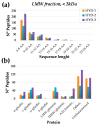Prototype Gluten-Free Breads from Processed Durum Wheat: Use of Monovarietal Flours and Implications for Gluten Detoxification Strategies
- PMID: 33327648
- PMCID: PMC7765144
- DOI: 10.3390/nu12123824
Prototype Gluten-Free Breads from Processed Durum Wheat: Use of Monovarietal Flours and Implications for Gluten Detoxification Strategies
Abstract
In this investigation, we reported the production of prototype breads from the processed flours of three specific Triticum turgidum wheat genotypes that were selected in our previous investigation for their potential low toxic/immunogenic activity for celiac disease (CD) patients. The flours were subjected to sourdough fermentation with a mixture of selected Lactobacillus strains, and in presence of fungal endoproteases. The breads were characterized by R5 competitive enzyme linked immunosorbent assay in order to quantify the residual gluten, and the differential efficacy in gluten degradation was assessed. In particular, two of them were classified as gluten-free (<20 ppm) and very low-gluten content (<100 ppm) breads, respectively, whereas the third monovarietal prototype retained a gluten content that was well above the safety threshold prescribed for direct consumption by CD patients. In order to investigate such a genotype-dependent efficiency of the detoxification method applied, an advanced proteomic characterization by high-resolution tandem mass spectrometry was performed. Notably, to the best of our knowledge, this is the first proteomic investigation which benefitted, for protein identification, from the full sequencing of the Triticum turgidum ssp. durum genome. The differences of the proteins' primary structures affecting their susceptibility to hydrolysis were investigated. As a confirmation of the previous immunoassay-based results, two out of the three breads made with the processed flours presented an exhaustive degradation of the epitopic sequences that are relevant for CD immune stimulatory activity. The list of the detected epitopes was analyzed and critically discussed in light of their susceptibility to the detoxification strategy applied. Finally, in-vitro experiments of human gastroduodenal digestion were carried out in order to assess, in-silico, the toxicity risk of the prototype breads under investigation for direct consumption by CD patients. This approach allowed us to confirm the total degradation of the epitopic sequences upon gastro-duodenal digestion.
Keywords: celiac disease; detoxification strategies; epitopes; gluten-free; in-vitro simulated human gastroduodenal digestion; sourdough.
Conflict of interest statement
The authors declare no conflict of interest.
Figures


References
-
- Ribeiro M., Rodríguez-Quijano M., Nunes F.M., Carrillo J.M., Branlard G., Igrejas G. New insights into wheat toxicity: Breeding did not seem to contribute to a prevalence of potential celiac disease’s immunostimulatory epitopes. Food Chem. 2016;213:8–18. doi: 10.1016/j.foodchem.2016.06.043. - DOI - PubMed
MeSH terms
Substances
Grants and funding
LinkOut - more resources
Full Text Sources
Research Materials

